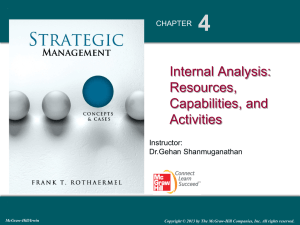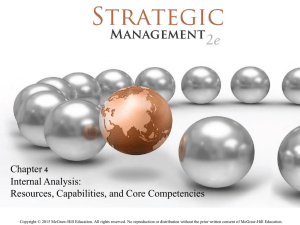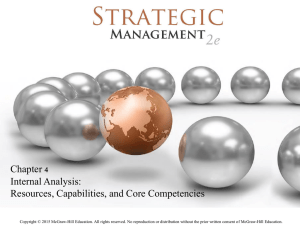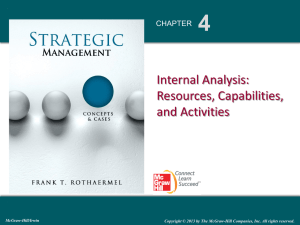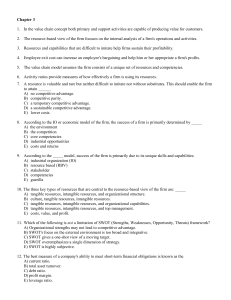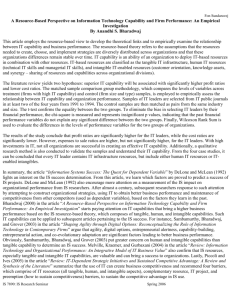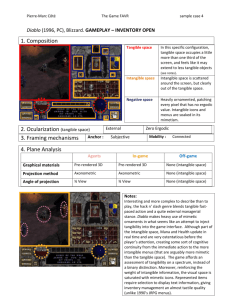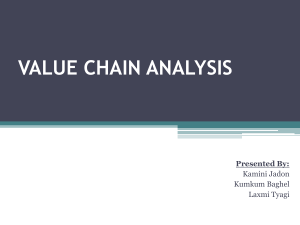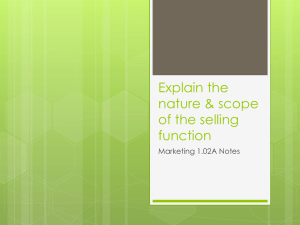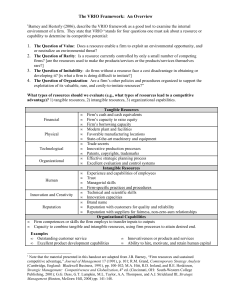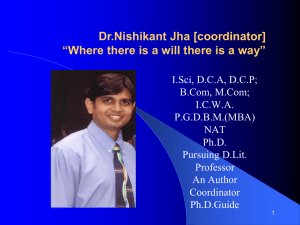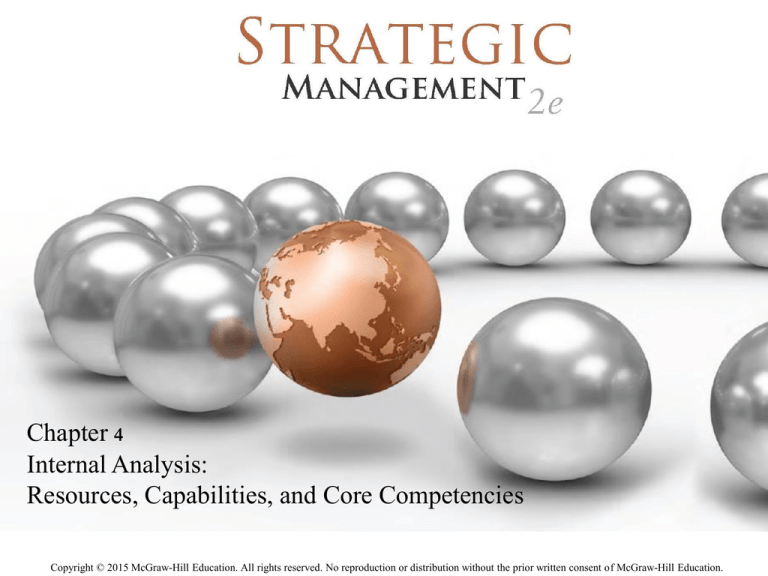
Chapter 4
Internal Analysis:
Resources, Capabilities, and Core Competencies
Copyright © 2015 McGraw-Hill Education. All rights reserved. No reproduction or distribution without the prior written consent of McGraw-Hill Education.
4-2
4.1 Looking Inside the Firm for
Core Competencies
Competitive advantage derives from core competencies,
which enable:
• Differentiation of products/services creating perceived
value, or
• Cost leadership – offering products/services of comparable
value at lower cost
NIKE – Core Competence – Just Do It
• Unlocking human potential
• Anyone can be a hero
4-3
KEY CONCEPTS
Developing the product /service markets [visible side]
is just as important as leveraging core competencies
[invisible side].
Honda has developed a distinct competency in
engines with a business model of locating places to
place these engines – from cars, SUVs, vans, trucks,
motorcycles, ATVs, boats, airplanes, generators, snow
blowers, lawn mowers, other yard equipment, etc.
4-4
Exhibit 4.2
Looking Inside the Firm for
Competitive Advantage, Resources, Capabilities,
Core Competencies, and Activities
4-5
Exhibit 4.4 Linking Resources, Capabilities,
Core Competencies, and Activities to Competitive
Advantage and Superior Firm Performance
4-6
4.2 The Resource-Based View
Resources are key to superior firm performance.
If resources and capabilities exhibit VRIO attributes,
they become the building blocks for gaining and
sustaining competitive advantage.
VRIO
•
•
•
•
(V) Valuable
(R) Rare
(I) Costly to imitate
(O) Organized to capture the value of the resource/capability
4-7
The VRIO Framework
Valuable
• Attractive features
• Lower costs (& price)
Higher profits
• Honda – design & build
engines
Rare
• Only a few firms
possess
• Toyota – lean
manufacturing
Costly to Imitate
• Unable to develop or
buy at a reasonable price
• Nike – Yes
• Crocs – No
Organized to Capture
• Exploit competitive
potential
Structure
Coordinating systems
• Xerox PARC – No
Temporary competitive
advantage
4-8
4.2 The Resource-Based View
Competitive advantage is more likely to develop
from intangible rather than tangible resources..
Tangible and Intangible Resources – Examples:
Apple
• Tangible Resource Value: $15 Billion
• Intangible Resource Value: $180 Billion
Google
• Tangible Resource Value: $8 Billion
• Intangible Resource Value: $110 Billion
4-9
Exhibit 4.5
Tangible and Intangible Resources
4-10
Exhibit 4.6 Applying the
Resource-Based View: A Decision Tree Revealing
Competitive Implications
4-11
HOW TO SUSTAIN A COMPETITIVE
ADVANTAGE
Isolating Mechanisms
1. Better Expectations of Future Values
• Buy Resources at a low cost.
Nike signing future mega-athletes early in their career (i.e., Michael
Jordan)
Real estate development- Highway expansion
2.
Path Dependence
• Current alternatives are limited by past decisions.
Geographic concentration of the U.S. carpet industry
GM’s problems competing with Toyota Prius was decades in the
making.
4-12
HOW TO SUSTAIN A COMPETITIVE
ADVANTAGE (cont’d)
3. Causal Ambiguity
• Cause of success or failure is not apparent.
Why has Apple had such a string of successful products?
Role of Steve Job’s vision?
Unique talents of the Apple design team?
Timing of product introductions?
4. Social Complexity
• Two or more systems interact creating many possibilities.
A group of 3 people has 3 relationships.
A group of 5 people has 10 relationships.
4-13
SUMMARY
Taken together, a firm may be able to protect its
competitive advantage – even for long periods of time –
when its managers have consistently:
1. Better expectations about the future value of resources.
2. Have accumulated a resource advantage that can be
imitated only over long periods of time.
3. When the source of their competitive advantage is
causally ambiguous or socially complex.
4-14
4.3 The Dynamic Capabilities
Perspective
A firm’s ability to create, deploy, modify, reconfigure,
upgrade, or leverage its resources in its quest for
competitive advantage
Essential to create a sustained competitive advantage
• A dynamic fit between internal strengths and external
opportunities
Resource stocks – current level of intangible
resources
Resource flows – investments to maintain or build a
resource
4-15
4.4 The Value Chain Analysis
The internal activities a firm engages in when
transforming inputs into outputs
Each activity adds incremental value and associated
costs.
This concept can be applied to any firm – goods or
service.
The value chain helps to assess which parts add
value and which do not.
4-16
Exhibit 4.8 A Generic Value Chain:
Primary and Support Activities
4-17
PRIMARY AND SUPPORT ACTIVITIES
The value chain is divided into primary and support
activities.
Primary activities – Firm activities that add value
directly by transforming inputs into outputs as the
firm moves a product or service horizontally along
the internal value chain
Support activities – Firm activities that add value
indirectly, but are necessary to sustain primary
activities
4-18
4.5 Implications for the Strategist
USING SWOT ANALYSIS TO COMBINE EXTERNAL
AND INTERNAL ANALYSIS
Synthesizes internal analysis of the company’s
strengths and weaknesses (S and W) with those from
an analysis of external opportunities and threats
(O and T)
SWOT =
• VRIO framework plus
• PESTEL plus
• Porter’s five forces analyses
4-19
Exhibit 4.10 Strategic Questions
within the SWOT Matrix
4-20
4-21

